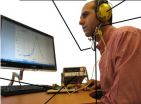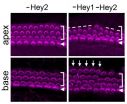(Press-News.org) A chin strap that can harvest energy from jaw movements has been created by a group of researchers in Canada.
It is hoped that the device can generate electricity from eating, chewing and talking, and power a number of small-scale implantable or wearable electronic devices, such as hearing aids, cochlear implants, electronic hearing protectors and communication devices.
The first results of the device's performance have been published today, 17 September, in IOP Publishing's journal Smart Materials and Structures.
Jaw movements have proved to be one of the most promising candidates for generating electricity from human body movements, with researchers estimating that an average of around 7 mW of power could be generated from chewing during meals alone.
To harvest this energy, the study's researchers, from Sonomax-ÉTS Industrial Research Chair in In-ear Technologies (CRITIAS) at École de technologie supérieure (ÉTS) in Montreal, Canada, created a chin strap made from piezoelectric fiber composites (PFC).
PFC is a type of piezoelectric smart material that consists of integrated electrodes and an adhesive polymer matrix. The material is able to produce an electric charge when it stretches and is subjected to mechanical stress.
In their study, the researchers created an energy harvesting chin strap made from a single layer of PFC and attached it to a pair of ear muffs using a pair of elastic side straps. To ensure maximum performance, the chin strap was fitted snugly to the user, so when the user's jaw moved it caused the strap to stretch.
To test the performance of the device, the subject was asked to chew gum for 60 seconds whilst wearing the head-mounted device; at the same time the researchers recorded a number of different parameters.
The maximum amount of power that could be harvested from the jaw movements was around 18 µW, but taking into account the optimum set-up for the head-mounted device, the power output was around 10 µW.
Co-author of the study Aidin Delnavaz said: "Given that the average power available from chewing is around 7 mW, we still have a long way to go before we perfect the performance of the device.
"The power level we achieved is hardly sufficient for powering electrical devices at the moment; however, we can multiply the power output by adding more PFC layers to the chin strap. For example, 20 PFC layers, with a total thickness of 6 mm, would be able to power a 200 µW intelligent hearing protector."
One additional motivation for pursuing this area of research is the desire to curb the current dependency on batteries, which are not only expensive to replace but also extremely damaging to the environment if they are not disposed of properly.
"The only expensive part of the energy harvesting device is the single PFC layer, which costs around $20. Considering the price and short lifetime of batteries, we estimate that a self-powered hearing protector based on the proposed chin strap energy harvesting device will start to pay back the investment after three years of use," continued Delnavaz.
"Additionally, the device could substantially decrease the environmental impact of batteries and bring more comfort to users.
"We will now look at ways to increase the number of piezoelectric elements in the chin strap to supply the power that small electronic devices demand, and also develop an appropriate power management circuit so that a tiny, rechargeable battery can be integrated into the device."
INFORMATION:
From Wednesday 17 September, this paper can be downloaded from http://iopscience.iop.org/0964-1726/23/10/105020
Notes to Editors
Contact
1. For further information, a full draft of the journal paper or contact with one of the researchers, contact IOP Press Officer, Michael Bishop: Tel: 0117 930 1032 E-mail: michael.bishop@iop.org For more information on how to use the embargoed material above, please refer to our embargo policy.
IOP Publishing Journalist Area
2. The IOP Publishing Journalist Area gives journalists access to embargoed press releases, advanced copies of papers, supplementary images and videos. In addition to this, a weekly news digest is uploaded into the Journalist Area every Friday, highlighting a selection of newsworthy papers set to be published in the following week. Login details also give free access to IOPscience, IOP Publishing's journal platform. To apply for a free subscription to this service, please email Michael Bishop, IOP Press Officer, michael.bishop@iop.org, with your name, organisation, address and a preferred username.
Flexible piezoelectric energy harvesting from jaw movements
3. The published version of the paper 'Flexible piezoelectric energy harvesting from jaw movements' (Delnavaz A and Voix J 2014 Smart Mater. Struct. 23 105020) will be freely available online from Wednesday 17 September. It will be available at http://iopscience.iop.org/0964-1726/23/10/105020.
Smart Materials and Structures
4. Smart Materials and Structures is dedicated to technical advances in smart materials, systems and structures, including materials, sensing and actuation, optics and electromagnetics, structures, control and information processing.
IOP Publishing
5. IOP Publishing provides publications through which leading-edge scientific research is distributed worldwide.
Beyond our traditional journals programme, we make high-value scientific information easily accessible through an ever-evolving portfolio of books, community websites, magazines, conference proceedings and a multitude of electronic services.
IOP Publishing is central to the Institute of Physics, a not-for-profit society. Any financial surplus earned by IOP Publishing goes to support science through the activities of the Institute. Go to http://ioppublishing.org.
Access to Research
6. Access to Research is an initiative through which the UK public can gain free, walk-in access to a wide range of academic articles and research at their local library. This article is freely available through this initiative. For more information, go to http://www.accesstoresearch.org.uk
The Institute of Physics
6. The Institute of Physics is a leading scientific society. We are a charitable organisation with a worldwide membership of more than 50,000, working together to advance physics education, research and application.
We engage with policymakers and the general public to develop awareness and understanding of the value of physics and, through IOP Publishing, we are world leaders in professional scientific communications.
In September 2013, we launched our first fundraising campaign. Our campaign, Opportunity Physics, offers you the chance to support the work that we do.
'Smart material' chin strap harvests energy from chewing
2014-09-17
ELSE PRESS RELEASES FROM THIS DATE:
World Alzheimer Report 2014 reveals persuasive evidence for dementia risk reduction
2014-09-17
The World Alzheimer Report 2014 'Dementia and Risk Reduction: An analysis of protective and modifiable factors', released today, calls for dementia to be integrated into both global and national public health programmes alongside other major non communicable diseases (NCDs).
Alzheimer's Disease International (ADI) commissioned a team of researchers, led by Professor Martin Prince from King's College London, to produce the report. ADI is publishing this report, in conjunction with World Alzheimer's Day™ (21 September) and as a part of World Alzheimer's Month, an international ...
Diabetes complications make patients more likely to fall down stairs
2014-09-17
New research presented at this year's annual meeting of the European Association for the Study of Diabetes (EASD) in Vienna, Austria, shows that people suffering from diabetic peripheral neuropathy (DPN)—a complication of diabetes that affects the nerves in the limbs—are likely to sway more during stair climbing, and thus are more likely to fall. Steven Brown, Manchester Metropolitan University, UK, is the lead author on this research, which has been conducted by researchers at Manchester Metropolitan University and the University of Manchester, UK.
Patients with DPN ...
Study shows users of insulin pumps are at 29 percent lower risk of death compared with patients on insulin injections
2014-09-17
A study of more than 18,000 patients with type 1 diabetes has shown that use of insulin pumps to administer insulin rather than treatment with multiple daily insulin injections results in a 29% reduction in all-cause mortality and 43% reduction in the risk of fatal cardiovascular disease (CVD, i.e. coronary heart disease or stroke). The study is presented at the annual meeting of the European Association for the Study of Diabetes in Vienna, Austria, and was prepared by Dr Soffia Gudbjörnsdottir, University of Gothenburg, Sweden and colleagues.
Insulin pump treatment (CSII ...
The Lancet: Scientists use modern forensic techniques to identify most likely cause of King Richard III's death
2014-09-17
New research led by the University of Leicester in the UK gives a blow-by-blow account of the injuries inflicted on King Richard III's body at the Battle of Bosworth Field on Aug 22, 1485. Modern forensic analysis of the King's skeletal remains reveals that three of his injuries had the potential to cause death quickly—two to the skull (page 4, figure 4) and one to the pelvis (page 5, figure 6).
The remains of King Richard III—the last English monarch to die in battle—were found under a car park in Leicester by archaeologists from the University of Leicester, and subsequently ...
Urine HPV test could offer non-invasive alternative to conventional smear, improve screening uptake
2014-09-17
Human papillomavirus (HPV) is one of the most common sexually transmitted infections. Up to 80% of sexually active women are infected at some point in their lives and infection with specific "high risk" strains of HPV has an established link to cervical cancer.
Current screening by cervical cytology (smear test) is invasive and time-consuming - and in recent years, cervical screening in the UK has fallen below 80%, particularly amongst women aged 25-30. Several studies have suggested that detecting HPV in urine may be a feasible alternative to cervical sampling, but the ...
Hey1 and Hey2 ensure inner ear 'hair cells' are made at the right time, in the right place
2014-09-17
Two Johns Hopkins neuroscientists have discovered the "molecular brakes" that time the generation of important cells in the inner ear cochleas of mice. These "hair cells" translate sound waves into electrical signals that are carried to the brain and are interpreted as sounds. If the arrangement of the cells is disordered, hearing is impaired.
A summary of the research will be published in The Journal of Neuroscience on Sept. 16.
"The proteins Hey1 and Hey2 act as brakes to prevent hair cell generation until the time is right," says Angelika Doetzlhofer, Ph.D., an ...
36 Pit Fire in Oregon
2014-09-17
The 36 Pit Fire began on September 13, 2014. The fire is human-caused and is still under investigation. It is currently over 2,300 acres in size and is mostly being fueled by grass and timber. The 36 Pit Fire was calm Monday night due to higher humidity. Yesterday (8/15), firefighters made progress in establishing an anchor point and beginning to construct a fireline on the West and North sides of the fire.
The following resources are working on the fire:
7 20-person Crews
4 Hot Shot Crews
1 large Type 1 Helicopter
2 medium Type 2 Helicopter
2 bulldozer
17 ...
Focus on treatment costs, value: Less radiation for elderly women with early breast cancer
2014-09-16
(September 16th, 2014; San Francisco) – In a healthcare climate where the costs of treatment are increasingly weighed against potential benefit, a Yale study has found that radiation oncologists are using fewer or less-aggressive radiation procedures on elderly women with early-stage breast cancer. The findings are scheduled to be presented at the 56th annual conference of the American Society for Radiation Oncology in San Francisco. (Abstract 131: Evaluating National Practice in Radiotherapy for Elderly Women: Response to a Randomized Trial and Cost Effectiveness on a ...
Effect of magnesium sulfate during pregnancy on very preterm infants
2014-09-16
Magnesium sulfate given intravenously to pregnant women at risk of very preterm birth was not associated with benefit on neurological, behavioral, growth, or functional outcomes in their children at school age, according to a study in the September 17 issue of JAMA.
Rates of adverse long-term neurodevelopmental outcomes for infants born at less than 28 weeks' gestation remain high relative to full-term infants. Among the multiple uses for magnesium sulfate in obstetrics is as a neuroprotectant for preterm fetuses. Antenatal (before birth) magnesium sulfate given to pregnant ...
Waistlines of US adults continue to increase
2014-09-16
The prevalence of abdominal obesity and average waist circumference increased among U.S. adults from 1999 to 2012, according to a study in the September 17 issue of JAMA.
Waist circumference is a simple measure of total and intra-abdominal body fat. Although the prevalence of abdominal obesity has increased in the United States through 2008, its trend in recent years has not been known, according to background information in the article.
Earl S. Ford, M.D., M.P.H., of the U.S. Centers for Disease Control and Prevention, Atlanta, and colleagues used data from seven ...


